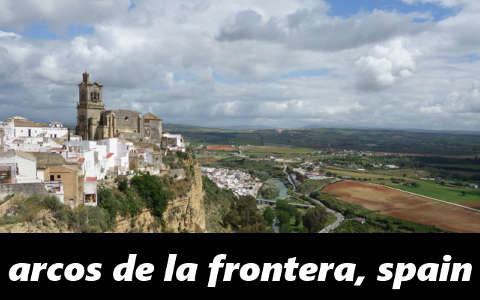One of the quintessential Andalusian White Villages (Pueblos Blancos), Arcos de la Frontera has a mix of the old world and the new world. However, since it is its old world charm that everyone comes here for, our quick trip will focus on the old town.
We will start at Plaza del Cabildo, at the center of old town Arcos (see GETTING HERE below on arrival info).
At one end of the plaza is the striking church, Basílica de Santa María de la Asunción. This church, like many in Andalusia, was built on the site of an old mosque after Christian Reconquista. Inside, it features a Baroque high altar, an Easter candle from 1767, and the “incorruptible” (undecomposed) relic of St Felix (you be the judge on the “incorruptible” part when you actually visit).
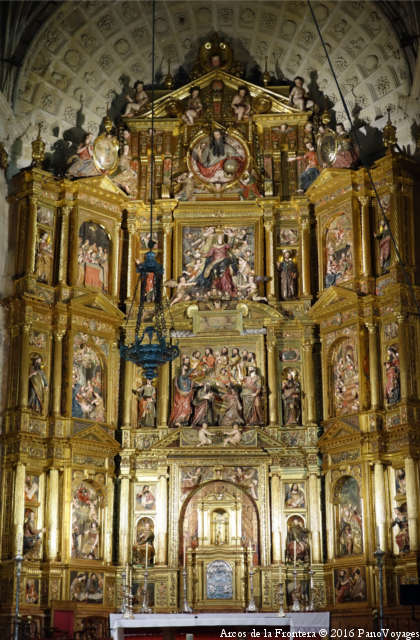
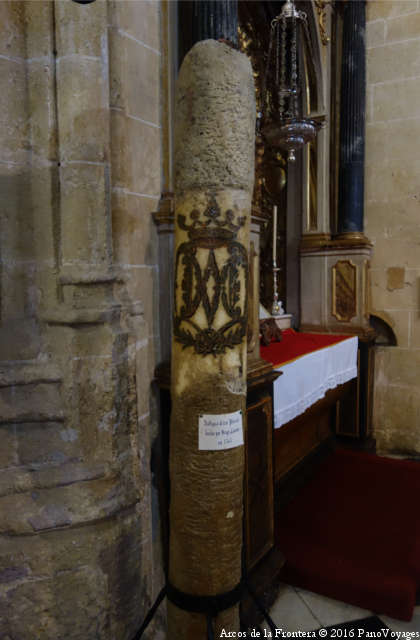
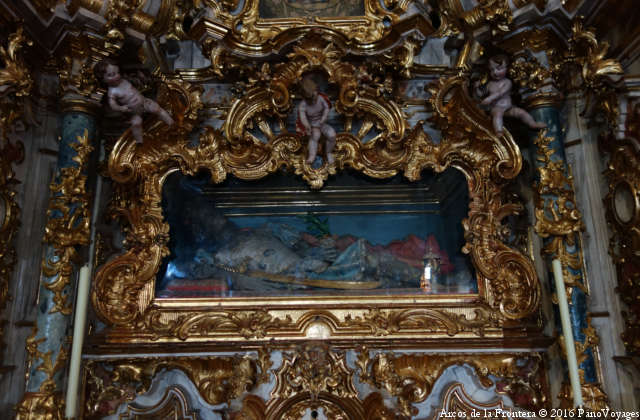
Back on the plaza, to the left of the church (as you face the church) is a medieval castle behind the city hall. It’s privately owned, so unless you are invited, don’t try to go inside.
To the right of the church is the Parador (see its website here). If you want to spend a night in Arcos and can afford a splurge, get a room here with balcony view. Otherwise, stop here for a drink or meal on its restaurant terrace. The service is so-so, but the views can’t be beat!
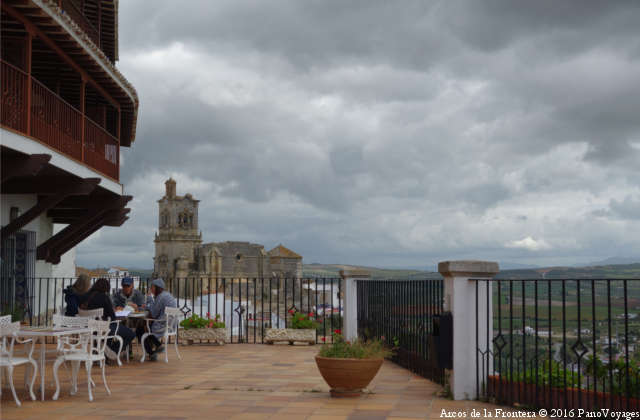
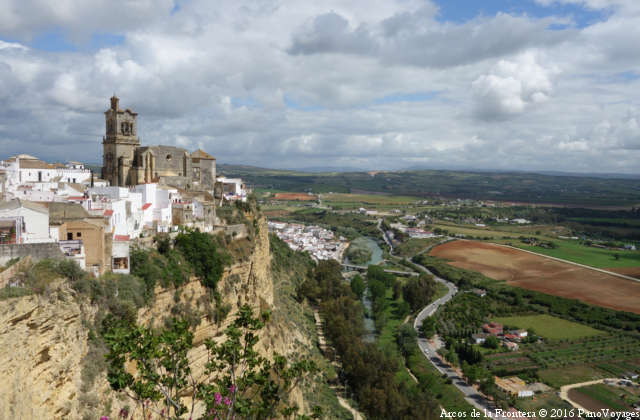
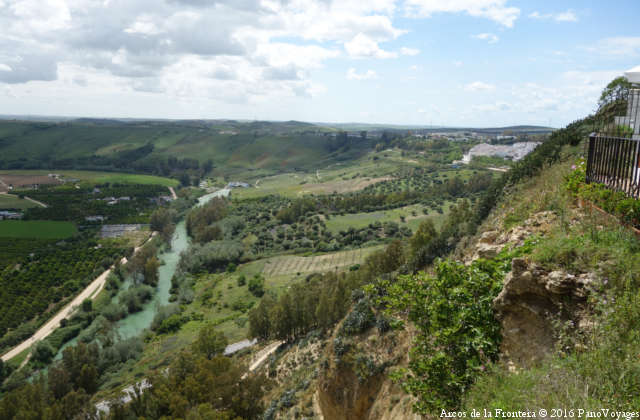
Don’t want to spend any money but still want a great view? No problem. Directly across from the church is a view point (turn 180-degrees from the church on Google Street View above, and see the terrace behind the white gate). You can get a breathtaking view of Guadalete River valley hundreds of feet under and look at the back of birds as they flew below you.
From Plaza del Cabildo, stroll down Calle Escribanos for a minute or two, and you will get to Plaza Boticas.
The prominent building here with iron grills over windows is a convent (Convento de las Mercedarias Descalzas); if you are lucky, you might be here when they are open for selling their freshly baked cookies. Next door is the town’s market (pan left on Street View above and you will immediately see a structure with a mixture of white-wash and stone walls). Zoom in a little, and you can actually part of the structure looking like a church; in fact, at one time, it was a church under construction. Move along the street a little further, and you can take a peek inside its patio.
Continue down Calle Boticas, and you will soon reach Iglesia de San Pedro (St Peter Church).
When we visited Arcos de la Frontera, this church was closed for siesta, so we didn’t get a chance to go inside (if you have some photos inside this church you want to share, please feel free to email us).
Across from the church and up the street (pan right on Street View above), you will see a building featuring small second floor patio with three flag poles. This is Palacio del Mayorazgo, a house-palace built in Herrerian style, highlighting Tuscan columns flanking its entrance and Mudejar arches for its roof deck; it is run by the city and are open to public in the morning. Attached to this building is San Miguel Association (Asociación de Pensionistas San Miguel), a public space featuring both historical antiques and new arts. It’s worth a quick stop as the courtyard is very pleasant.
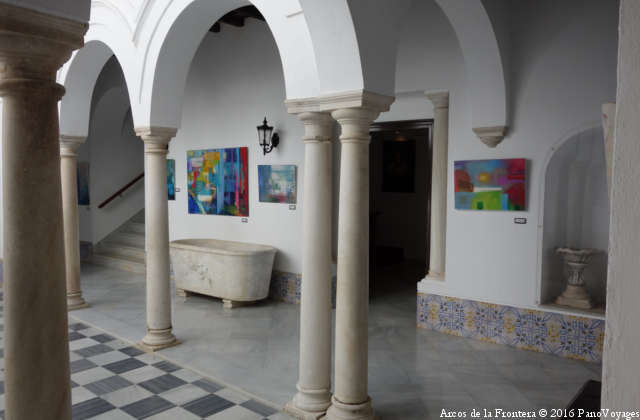
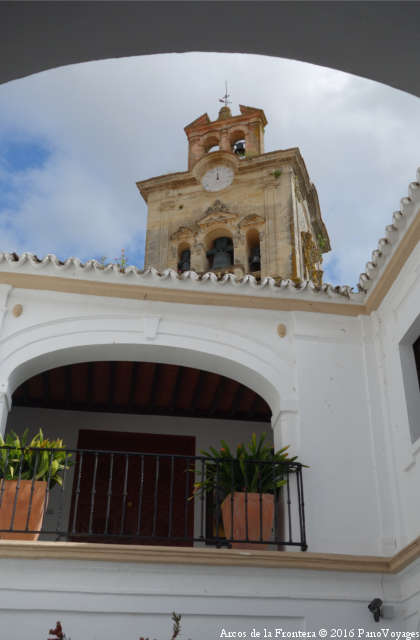
Before you leave the Street View above, check out the column set in the corner of the white building in front of Palacio del Mayorazgo. These corner columns are all over Arcos, some of them dating back to Roman time.
A great place to shop (or window-shop) for local souvenir is a short hop away from Iglesia de San Pedro (on Street View above, follow the traffic direction and you will soon see an “EXPOSICION CERAMICA ARTISTICA” sign on the left). This is Galería de Arte San Pedro; selling local artworks (paintings, pottery, tiles, …etc.), the person manning the store is usually working on his or her craft for you to see.
Take the small lane across from Galería de Arte San Pedro and it will take you to a nice set of cascading terraces on Calle Abades, granting you another breathtaking view of the reservoir west of the town.
If you bought some cookies from the convent at Plaza Boticas, this would be a great place to sit on a bench, enjoy the panoramic view, and munch on some sweet cookies.
GETTING HERE: You can drive to Plaza del Cabildo, but make sure you have a small rental car (and perhaps fold in rearview mirrors), as the streets here is one way, tiny, and winding. As you drive by the back of Basílica de Santa María de la Asunción (you will go under a few flying buttresses supporting the church, if you dare to take your eyes off the road and look up), look for a lane on the right with parking or Parador sign and turn there, and it will lead you to the plaza (make sure you pay the parking meter). If you miss the turn (as we did), you need to circle around and try your luck again.
If driving up a narrow, hilly, one-way lane in a rental car is not your cup of tea, park at an underground parking lot at Plaza España in the new town area.
It is a 10 minute walk to Plaza del Cabildo. There is also a shuttle bus that will take you up there, but since we didn’t use it during our visit (and our research couldn’t turn out the exact spot where the shuttle bus stops at this parking lot), we recommend looking or asking around. TripAdvisor has a post on what the bus look like (click here to see that post). A better way may be walking up to Plaza del Cabildo, and see if you can find out where the shuttle bus boards so you can take it back down.
If you take a bus to Arcos, the bus station is about a 15 minute way to Plaza del Cabildo. Again, the shuttle bus is supposed to stop here.
Two bus companies serves Arcos de la Frontera, Los Amarillos (see website here) and Transportes Generales Comes (see website here). A bus trips from Jerez takes from 30 to 45 minutes, while direct buses from Seville takes 2 hours or more (2 trips per day on Los Amarillos; more connections at Jerez). Take you sense of adventure (and patience) and schedule extra time when you take buses around small towns in Andalusia; they often run late, and ticket windows may not be open (you can pay on bus).
Los Amarillos has more bus per day than T.G. Comes. Though both websites offer English options, searching on them may be a bit tricky; don’t search for more than a few days in advance, and you may need to know each city’s full name and its province: both Jerez (or Jerez de la Frontera) and Arcos de la Frontera are in Cádiz province, and Seville (or Sevilla) is in the province of Seville. Bus departs Seville’s Prado San Sebastián station (see google maps location here) and not Plaza de Armas.

